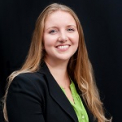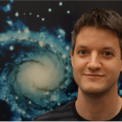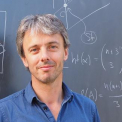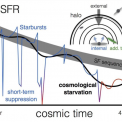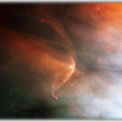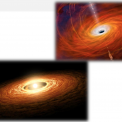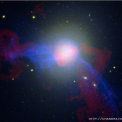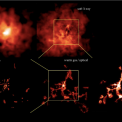I will introduce two new space telescopes concepts that can observe exoplanet systems across ultraviolet wavelengths. The first is SPARCS (Star-Planet Activity Research CubeSat), hopefully launching next year, and the second is UV-SCOPE (Ultraviolet Spectroscopic Characterization of Planets and their Environments) which is currently under review within NASA’s Medium-class Explorer program. Both SPARCS and UV-SCOPE are driven by the need to better understand the current and past UV exposure experienced by exoplanets and how this exposure influences the demographics and habitability of small exoplanets. Both missions will also improve our understanding of the UV history of M and K stars (the most likely hosts of potentially habitable worlds) as well as improve our understanding of two important exoplanet atmospheric phenomena --- cloud formation and atmospheric escape.
Events: Special Colloquia
-
Space Telescopes for Exoplanet Science
-
2022 Chhabra-Landau Lecture: Meeting Dirac’s Challenge: Quantum Many-body Physics in the 21st Century
In 1929 Paul Adrian Maurice Dirac wrote, with complete theoretical justification, “The underlying physical laws necessary for the mathematical theory of a large part of physics and the whole of chemistry are thus completely known” and he continued , “... the difficulty is only that the exact application of these laws leads to equations much too complicated to be soluble. It therefore becomes desirable that approximate practical methods of applying quantum mechanics should be developed, which can lead to an explanation of the main features of complex atomic systems without too much computation.’’ This talk will present recent spectacular progress towards meeting Dirac’s challenge. The key insight, important on multiple levels, is that the quantum many-body problem is in essence a big data problem, with the solutions all revolving around appropriate compression of information. Crucial to the practical solution is a multimessenger approach demanding consistency between different methods. Specific examples and important open questions and challenges will be discussed.
Learn more about our speaker and the Chhabra-Landau Lecture Series in this news post:
The 2022 Chhabra-Landau Lecture, April 7, 3:55 PM -
Millimeter/submillimeter spectroscopic detection of desorbed ices
-
2021 Chhabra-Landau Lecture: Machine Learning Based Ab-initio Molecular Dynamics
Computational cost severely limits the range of ab initio molecular dynamics simulations. Machine learning techniques are rapidly changing this state of affairs. Deep neural networks, that learn the interatomic potential energy surface from ab-initio data, make possible simulations with quantum mechanical accuracy at the cost of empirical force fields. These approaches can model not only atomistic dynamics but also dielectric response properties measured in experiments. I will discuss, in particular, the deep potential method developed at Princeton. In combination with incremental learning techniques, this approach makes possible to construct, with minimal learning cost, reactive potentials that are accurate over a vast range of thermodynamic conditions, such as the pressure and temperature regimes underlying molecular and ionic phases of water. The methodology will be illustrated with applications to some classic problems in physical chemistry.
About the Speaker
Roberto Car is the Ralph W. Dornte Professor in Chemistry at Princeton University, and Professor of Chemistry in the Princeton Institute for the Science and Technology of Materials. In 2016, Dr. Car was elected as a member of the National Academy of Sciences for his distinguished achievements in scientific research. Among his many awards he has received the A. Rahman Prize of the American Physical Society and the Dirac Medal and Prize of the International Centre for Theoretical Physics.
Learn more about Dr. Roberto Car in our recent news feature: https://www.physast.uga.edu/blogs/news/posts/2021-chhabra-landau-lecture-announced
-
When Stars Go Nonlinear: Large Amplitude Tides and Stellar Oscillations
Tides significantly impact the structure, evolution, and fate of many types of close binary systems, including short-period exoplanets, stellar binaries, and coalescing binary neutron stars. In many of these systems, the tide’s amplitude is so large that it cannot be treated as a small, linear perturbation to the background star. In this talk, I will show that nonlinear effects can greatly enhance the rate of tidal dissipation and thus the rate of binary evolution. As examples, I will describe how nonlinear tides influence the orbital decay of hot Jupiters and the gravitational-wave signal of coalescing binary neutron stars and white dwarfs. I will also discuss the nonlinearity of oscillation-modes in solar-like stars, which are excited by turbulent motions within the convective envelope. The rich oscillation spectra observed by space missions such as Kepler and TESS has revolutionized the field of asteroseismology and yielded a wealth of information about the internal and global properties of thousands of stars.
-
Gravitational Instability and Substructure in Protoplanetary Discs
In the ALMA era of observational astronomy, we are availed of a plethora of spatially resolved images of protoplanetary discs, the site of exoplanet formation. Significant substructure, such as spirals and ring-like gaps, has proved to be the norm, rather than the exception, in these systems. There is now a consensus that much of this substructure is caused by forming gas-giant exoplanets. However, this is problematic for our understanding of planet formation. These protoplanetary discs are typically a factor of 10 too young to have formed such massive planets in the standard core accretion paradigm, but it is also understood that planets do not form directly through gravitational collapse. When protoplanetary discs are very young, they are very massive relative to their host star, and therefore pass through a period of gravitational instability. This instability may accelerate the earliest stages of planet formation in the standard core accretion paradigm, offering a solution to the planet formation timescale problem. I discuss my research into gravitational instability and detection of substructure, and discuss future research plans which will explore the formation of exoplanets in dynamically evolving protoplanetary discs.
-
Engineering Colloidal Matter Through Computation
The ability to predict, design and make the perfect material with just the right properties to do what we want, how we want, and when we want is the holy grail of materials research. Such “materials on demand” require control over thermodynamics, kinetics, nonequilibrium behavior, and structure across many length and time scales. With continuing advances in computer simulation capabilities, we have never been closer to the goal, but many challenges – and opportunities – remain. Many of those are at the boundaries of the subfields of materials research, where ideas from one area spur advances in others, and where computational tools and concepts are transferable across domains and scales. At the same time, foundational understanding at one scale can help understand new discoveries at different scales, regardless of the nature of the material and the forces holding it together. In this lecture, we show how atomic and molecular crystal structures – made possible by chemical bonds – can be realized in silico for non-interacting nanoparticles and colloids via entropic bonds. We show that similar crystallization pathways are followed by both molecular and colloidal fluids regardless of driving forces or relevant length scales. Finally, we show how colloidal crystal prediction may be amenable to modern tools used for atomic crystal prediction.
-
The 25th Annual Cantrell Lecture Series: Representation theory and geometry
The 25th Annual Cantrell Lecture Series
This lecture series will focus on representation theory, from its origins in the study of finite groups by Frobenius in the final years of the 19th century, through to recent problems and questions. A theme throughout is the recurring presence of geometry in what at first appears an algebraic subject. The first lecture will be largely historical, and will provide a potted history of the subject up until the 1970s.
The 2019 Cantrell Lecture Speaker will be Professor Geordie Williamson of the University of Sydney.
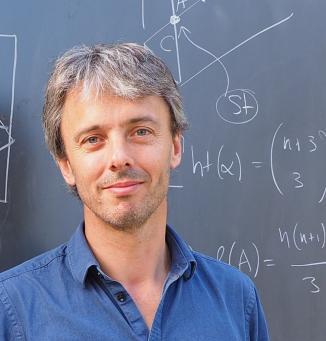 Professor Williamson is one of the world's foremost experts in geometric representation theory. His counterexamples to the Lusztig conjecture have led to new and exciting research in the area of modular representation theory, in which he is one of the leaders. Another of his major accomplishments involves joint work with Ben Elias which settled a long-standing conjecture about positivity of Kazhdan-Lusztig polynomials for arbitrary Coxeter groups. Professor Williamson was awarded the Chevalley prize of the AMS (2016), a Clay Research Award (2016), the EMS prize (2016), the New Horizons in Mathematics prize (2017), and was elected a Fellow of the Royal Society (2018).
Professor Williamson is one of the world's foremost experts in geometric representation theory. His counterexamples to the Lusztig conjecture have led to new and exciting research in the area of modular representation theory, in which he is one of the leaders. Another of his major accomplishments involves joint work with Ben Elias which settled a long-standing conjecture about positivity of Kazhdan-Lusztig polynomials for arbitrary Coxeter groups. Professor Williamson was awarded the Chevalley prize of the AMS (2016), a Clay Research Award (2016), the EMS prize (2016), the New Horizons in Mathematics prize (2017), and was elected a Fellow of the Royal Society (2018).Refreshments will be served at 3:00pm in the Physics Lobby.
-
Why do galaxies stop making stars?
It has long been known that many massive galaxies in today's Universe show low or vanishing levels of star formation activity. Several promising explanations have been proposed that explain these observations, but a number of theoretical puzzles remain. In particular, the theoretical challenge has deepened with recent observations of passive galaxies at earlier times when the Universe was merely a few billion years old. At such early times, strong gas accretion from the cosmic environment, as predicted by cosmological simulations, should have sustained a vigorous star formation activity. I will discuss recent insights based on ultra-high resolution, cosmological simulations and present evidence that the star formation activity is dictated both by processes operating within galaxies as well as by their cosmological environment. This new perspective aligns well with recent empirical approaches and clarifies the role of internal and external processes in regulating star formation in galaxies.
-
Feeding and Feedback in the Interstellar Medium
Ongoing star formation in galaxies is mediated by the balance between feeding -- the accretion of new material from outside -- and feedback -- the energy and momentum injection from stellar processes -- in the interstellar medium. The ISM consists of three distinct gaseous phases, requiring different observational techniques to understand each phase. Modelling the multi-phase ISM requires capturing a wide range of scales and energy injection and transport processes, a task that is becoming feasible with modern (magneto)hydrodynamic simulations. I will present numerical simulations and observations of the ISM in the Milky Way and its environs tracing these feeding and feedback processes. I find that the gas microphysics keeps the ISM in the pressure regime in which all phases can coexist independent of any self-regulation processes changing the star formation rate. Feedback establishes pathways through which ionizing photons can travel from midplane O stars out of the disk, making diffuse warm ionized gas a natural consequence of star formation. On the feeding side of the star formation cycle, magnetic fields likely enable infalling gas to reach the plane and potentially contribute to ongoing star formation.
-
Accretion Disks From Black Holes to Planets
From powering the supermassive black holes in the centers of galaxies to forming the building blocks of planets and planetary systems, accretion disks are ubiquitous throughout the universe. Given this prevalence and parallel advances in computational astrophysics and observational capabilities, now is the quintessential time to understand how these complex systems work in their various guises. In this talk, I will present my vision for combining observational and theoretical tools to answer key questions related to both protoplanetary disks and high-energy disks around black holes. I will begin with an overview of accretion theory, describing the angular momentum transport problem in astrophysical disks, and how I am using sophisticated numerical simulations to solve this issue. I will then put this problem within the context of planet formation by describing how I am using numerical simulations as well as observations with the Atacama Large Millimeter/submillimeter Array (ALMA) to test current models and build a new paradigm for protoplanetary disk evolution. Finally, I will discuss theoretical work on the formation of planetary building blocks, called planetesimals, within the gas disk environment implied by observations and how the predicted properties of these planetesimals compare with those observed in the asteroid and Kuiper Belt planetesimal populations.
-
High Energy X-ray Astrophysics
I will demonstrate the rich physics we can learn from X-ray astronomy by highlighting two astrophysical systems with dramatically different size scales. On a large scale of a mega parsec (1 parsec = 3.26 light years), the X-ray emitting hot intracluster medium (ICM) of galaxy clusters is shock heated by the accretion of infalling materials. I will present theoretical models and the predicted X-ray signatures of the non- equilibrium ICM including electron-ion non-equipartition and non- equilibrium ionization (NEI) physics. On a small scale close to the accretion radius of the M87 supermassive black hole (~100 parsec), hard X-ray emission above 10 keV from its unresolved X-ray core has been detected, for the first time, with the NuSTAR X-ray Observatory. I will discuss our observational findings along with the origin of the X-ray emission, which is more likely to come from its relativistic jet rather than the accretion flow.
-
Raining on Galaxies and Black Holes: Unifying the Micro and Macro Properties of Feeding and Feedback
Feeding and feedback tied to supermassive black holes (SMBHs) play central role in the cosmic evolution of galaxies, groups, and clusters of galaxies. The self-regulated SMBH feeding-feedback cycle is matter of intense debate. I review key results of our numerical campaign to unveil how SMBHs are tightly coupled to the multiphase gaseous halos, linking the inner gravitational radius to the large Mpc scale and vice versa. Massively parallel magnetohydrodynamic simulations show the turbulent plasma halo radiatively cools via a top-down multiphase condensation rain of warm filaments and molecular clouds. The multiphase precipitation inherits the hot halo kinematics and thermodynamics, ultimately establishing a 'cosmic weather'. In the nuclear region, the recurrent collisions between the clouds and filaments promote angular momentum cancellation and boost the SMBH accretion rate through a mechanism known as Chaotic Cold Accretion (CCA). The CCA rapid variability triggers powerful black-hole outflows, which quench the macro cooling flow and star formation, while preserving the atmospheres of galaxies, groups, and clusters in global thermal equilibrium throughout cosmic time. I highlight the key imprints of black-hole feedback and feeding, such as bubbles, shocks, turbulence, and condensed structures, with a critical eye toward observational concordance, including the X-ray plasma, optical filaments, and radio molecular clouds.
-
First LIGO Observation of a Binary Black Hole Coalescence
Guest: Dr. Nathan Johnson-McDaniel, Tata International Center for Theoretical Studies, Bengaluru, India
Tuesday, April 12, 2016 3:30 pm - 4:30 pm
Location: Physics Auditorium (202)On September 14th, 2015, the two detectors of the Laser Interferometer Gravitational-Wave Observatory (LIGO) observed gravitational waves from a binary black hole coalescence. I will discuss the context and implications of this discovery. In particular, I will give an introduction to gravitational waves and prominent astrophysical sources, describe how LIGO is able to detect gravitational waves, and explain how to find gravitational wave signals in LIGO data.
I will then describe the (astro)physics we have gleaned from this first discovery, from binary black hole coalescence rates to tests of general relativity. I will end by looking forward to the many exciting future prospects for gravitational wave observations.
-
The History of the Universe from the beginning to the end: where did we come from, where can we go? A special lecture in memory of M.M. "Dunc" Duncan
Guest: Dr. John Mather, Nobel Prize winner and senior astrophysicist at NASA's Goddard Space Flight Center
Thursday, April 7, 2016 3:30 pm - 5:00 pm
Location: Physics Auditorium (202)I will outline the history of the universe from its early moments in the Big Bang, to the possible end. Our history is full of beneficial catastrophes, and we wouldn't be here without them: stars explode, the Moon is formed in a giant collision with the Earth, the Earth is bombarded by asteroids and comets for hundreds of millions of years, and multiple extinction events through hot, cold, poison, and asteroid impacts cause rapid evolution of life. But here we are, our ancestors survived and thrived through it all. Now, we can tell the story, we can look for more details, and we can begin to adventure through the solar system and eventually beyond, in partnership with a new entity, artificial intelligence coupled with robotics. Scientific discovery has been propelled by competition (including war) for thousands of years, so it's immensely important to public policy. I will illustrate with examples from NASA, including our measurements of the Big Bang, discoveries with the Hubble, and future telescopes like the James Webb Space Telescope (planned for 2018 launch) and beyond. Within a few decades, we may know that life is common in the universe, or perhaps not.
-
NASA Ames CubeSat Missions: A Short History of Nearly Everything and a Glimpse of the Future
Guest: Jasper Wolfe, Roberto Carlino, and Roger Hunter, NASA Ames Research Center
Friday, September 18, 2015 3:30 pm - 4:30 pm
Location: Physics Auditorium (202)NASA Ames Research Center has been a leading NASA advocate for CubeSat for a number of years, conducting a spectrum of missions including astrobiology (Pharma-Sat) to innovative low cost technology demonstrations, such as PhoneSat. Through the successful flights of dozens of these nanonsatellites from Ames, many lessons have been learned, discoveries made, technologies demonstrated, and paradigms shifted. This presentation will cover a "short history of nearly everything" to do with Ames CubeSats and how to get involved. We will include a brief view of the Cube-Sat event horizon and beyond. -
Search For Extraterrestrial Intelligence and Why It Will Fail
Guest: Ben Zuckerman, Research Professor and Emeritus, UCLA
Wednesday, March 4, 2015 7:00 pm - 8:00 pm
Location: Physics Auditorium (202)In recent years astronomers have discovered that essentially all stars are orbited by planets, thus raising the hopes of many persons that life and even technological life is common in our Milky Way galaxy and will soon be found. Notwithstanding the existence of so many planets, we present reasons why technological life is a very rare phenomenon and thus will be very difficult to discover.
-
Bubble Driven Catalytic Micromotors
Guest: Manoj Manjare, 2014 Kirkpatrick Award Recipient, UGA Physics and Astronomy
Wednesday, November 19, 2014 4:30 pm - 5:30 pm
Location: Physics Auditorium (202)This year (2014) we celebrate a decade anniversary of catalytic micromotors, in which they have come to represent one of the important technical advances, having shown promise in many important functions in biomedical and engineering fields such as sensing, detection, drug delivery, oil spill cleanup, etc. Catalytic nano-/ micromotors are structures that convert chemical energy present in the surrounding aqueous environment into mechanical work through a catalytic reaction induced by an asymmetrically placed catalyst. In this talk, we will look into different driving mechanisms of micromotors. The focus will be on bubble propulsion and it’s fundamentals.
The bubble propulsion mechanism is observed when the bubbles formed on the catalyst surface eject or burst. The motion of bubbles provides an opposing thrust to the motor. We have studied the motion of bubble propelled big Janus motors using a fast CCD camera. The formation of bubbles depends closely on the nucleation energy, which also is related to surface curvature. It is predicted that bubbles are easier to nucleate on a concave shaped surface than on a convex shaped surface. Thus, bubble propulsion can be easily seen in concave motors. The predictions were confirmed with nanoshell catalytic motors with catalyst coated inside the shell. Similarly, if the catalyst is coated in the inner surface of a tube, a tubular motor can be produced. We used graphene oxide nanosheets (GO) as templates and the stress effect in the multilayer of metal thin films to create microtubes.
Finally, collective motion with micromotors has emerged as an important concept. Collevtive behavior is observed through out the nature and can be emulated in the micromotor world. Using different properties of motional behaviors of motors, motors can be designed to perform tasks collectively. This can ultimately help in increasing the efficiency of completing tasks. We observe a unique collective bubbling with 5-μm diameter Janus motors. The bubbling has always been observed with individual motors, however, for the first time we observe bubble production through a collective effort.
-
SAMMI – 2nd Introductory Workshop on Small Animal MR Imaging 2014
Guest: Dr. Khan Hekmatyar
Tuesday, January 14, 2014 10:00 am - 1:00 pm
Location: Coverdell Center, Room 110CFrom the Workshop Page: Our first small animal MR imaging introductory workshop will provide an overview on the state of the art small animal 7T Agilent MRI magnet. This will provide an opportunity to discuss and see the demonstration of how the MRI imaging of animals is acquired and analysis of the image data and basic animal handling methods. Following this first workshop, another one will be conducted in the beginning of fall for using some advanced imaging techniques such as cardiac gating, diffusion techniques, contrast and angiography and spectroscopic techniques.
Beginners who want to learn more about the basic science and methods of small animal imaging as well as individuals with experience in small animal imaging are welcome to join this workshop. The workshop is limited to a maximum of 10 attendees per session. If more people sign up another session will be held.
Registration: http://www.ccrc.uga.edu/world/symposium/mri1.php
Proper one on one hands on training will be provided for researchers who would like to use our systems for their research.
-
Kepler: Nasa’s Search for Habitable Planets
Guest: Mr. Roger Hunter, Project Leader Kepler Mission
Friday, February 25, 2011 7:00 pm - 12:00 pm
Location: Physics 202 -
Dust and Ice: Their Roles in Astrophysical Environments
Tuesday, March 30, 2010 8:00 am - Thursday, April 1 5:00 pm
Location: CSP Conference RoomSecond workshop announcement:
Dust and Ice: Their Roles in Astrophysical Environments
to be held at the University of Georgia (UGA), March 30 – April 1, 2010, and sponsored by the Southeast Laboratory Astrophysics Community and its member institutions.
The workshop will provide a forum for discussions on dust grains, interstellar ices, and PAHs in astrophysical and atmospheric environments. In particular, advances and needs for relevant experimental and theoretical laboratory astrophysics will be highlighted.
The workshop will consist of invited talks and a poster session. Confirmed speakers include:
B-G Anderson (NASA/SOFIA); Ara Chutjian (NASA/JPL); Gary Douberly (UGA); Michael Duncan (UGA); Gary Ferland (U. Kentucky); Perry Gerakines (U. Alabama); Michael Henderson (PNNL); Eric Herbst (Ohio State U.); Carl Hirschmugl (U. Wiscon. Mil.); Doug Hudgins (NASA/HQ); Aigen Li (U. Missouri); Karin Oberg (Center for Astrophys.); Thom Orlando (GA Tech); Els Peeters (U. West. Ontario); Andrew Rappe (U. Penn.); Chad Soslik (Clemson U.); Angela Speck (U. Missouri); Gianfranco Vidali (Syracuse U.); Susanna Widicus Weaver (Emory U.)
Consult the local website (www.physast.uga.edu/workshops/dustandice) for additional information, to register for the meeting, and to submit talk or poster abstracts. Deadlines for hotel registration, meeting registration, and abstract submission are March 1, March 16, and March 16, respectively.
Workshop organizers: Gary Ferland, Perry Gerakines, Steven Lewis, David Schultz (SELAC Chair), Phillip Stancil, and Susanna Widicus Weaver.
SELAC’s purpose is to promote astronomy, astrophysics, and laboratory astrophysics in the region and more broadly. Funding provided by the Center for Simulational Physics and the Department of Physics and Astronomy, the University of Georgia.
-
Nano-Bio Cleanroom Symposium and Opening Ceremony
Friday, March 12, 2010 8:30 am - 5:00 pm
Location: Auditorium, Riverbend Research Laboratory SouthSymposium Goals: • To bring regional scientists to UGA to share their visions on the future of Nanobiotechnology and how to apply microfabrication and nanofabrication to biological research. • To celebrate the opening of UGA nano-bio cleanroom at the Riverbend Complex
Featured Speakers: Dr. Paul J. Joseph Nanotechnology Research Center, Georgia Institute of Technology; Dr. Chang Liu, Northwestern University; Dr. Ali Passian, Oak Ridge National Laboratory; Dr. Stephen P. DeWeerth, Wallace H. Coulter Department of Biomedical Engineering, Georgia Institute of Technology / Emory University.
Poster Submissions: Posters describing original nanotechnology and nanobiotechnology research will be available throughout the day. Poster abstracts of no more than 500 words should be emailed by March 5 to zhaoy@physast.uga.edu. Please include the title of the poster and names of all authors.
Registration: The symposium is free. Anyone from UGA or regional institutions is welcome to attend. Please RSVP your attendance to Yiping Zhao (zhaoy@physast.uga.edu) by March 5 for meeting arrangement purposes.
-
23rd Annual Center for Simulational Physics Workshop
Monday, February 22, 2010 8:00 am - Friday, February 26 5:00 pm
Location: CSP Conference Room (322)Recent Developments in Computer Simulation Studies in Condensed Matter Physics. Please see http://www.csp.uga.edu/Workshop/2010/ for registration details.
Page 1 of 1, showing 23 records out of 23 total, starting on record 1, ending on 23




